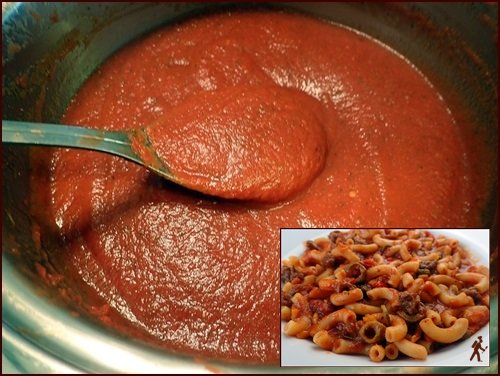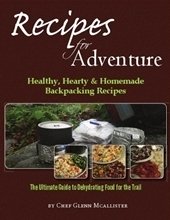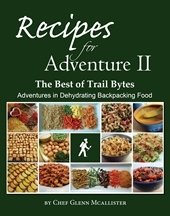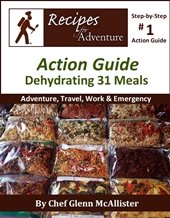Pasta Sauce
Recipes
This page features homemade pasta sauce recipes shared by Backpacking Chef readers, plus Chef Glenn’s recipe for traditional marina sauce. Instructions show how to cook and dehydrate it into tomato sauce leather and tomato sauce powder.
Photo: Making Chef Glenn’s marinara pasta sauce. Inset: Macaroni with Beef & Vegetables in Pasta Sauce.
Featured Pasta Sauce Recipes
Chef Glenn’s Marinara Pasta Sauce
Two-Mile High Bolognese Pasta Sauce
Pasta with Red Sauce & Ground Beef
Chef Glenn’s
Marinara Pasta Sauce Recipe

Photo: Cooked and blended pasta sauce ingredients spread on nonstick dehydrator tray and dried into tomato sauce leather and powder.
Ingredients:
- 6 cans diced tomatoes (6 x 14.5 oz. cans)
- 1 Tbsp. garlic powder
- 2 tsp. salt
- 2 tsp. sugar
- 1 tsp. onion powder
- ½ tsp. pepper
- 1 tsp. red pepper flakes *
- 1½ Tbsp. dried basil
- 2 tsp. dried oregano
- 2 tsp. dried parsley
- 4 bay leaves
- 2 Tbsp. red wine vinegar
Continue Reading: Complete instructions for cooking the marinara sauce and dehydrating it into tomato sauce leather and powder.
Two-Mile High Bolognese Pasta Sauce
Shared by Katherine Phillips from Denver, CO
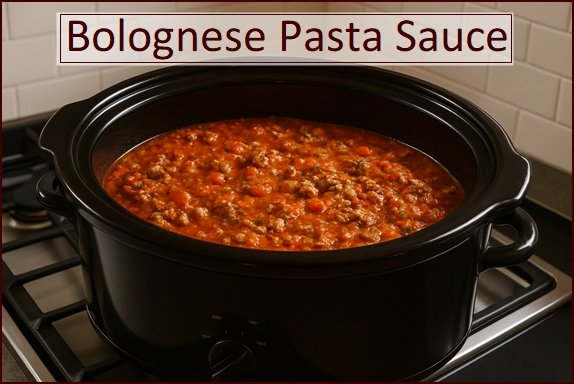
Katherine cooked and dehydrated this Bolognese pasta recipe at home and served it over Penne pasta to eight hungry hikers at 10,980 feet in the Rocky Mountains.
Ingredients:
- 1 lb. bulk Italian sausage
- 1 lb. boneless, skinless chicken thighs, cut into 1-inch chunks
- ¼ cup olive oil
- ½ cup chopped onion
- ½ cup chopped celery
- ½ cup chopped carrot
- 1 Tbsp. chopped garlic
- ½ cup dry red wine
- 1 can diced tomatoes in juice (28 oz.)
- 1 cup low sodium chicken or beef broth
- ¼ cup tomato paste
- 2 Tbsp. balsamic vinegar
- 1 bay leaf
- 1 tsp. kosher salt
- 1 tsp. dried oregano
- 1 tsp. fennel seeds
- ½ tsp red pepper flakes
How to Make Bolognese Pasta Sauce:
Mince onion, celery, carrot, and garlic.
Sauté sausage, chicken and onion in oil in a large sauté pan over medium-high heat until browned, five to seven minutes. Drain off fat and transfer to a 4 to 6-qt. slow cooker.
Add all other ingredients to slow cooker and mix well. Cook over low heat for four to six hours, then uncover and cook on high for one hour to thicken.
Dehydrate:
Remove meat chunks and dry on separate dehydrator trays. Tear larger chunks into smaller pieces.
Spread remaining mixture on dehydrator trays in thin layers.
Dehydrate at 145°F (63°C) until moisture is removed. Sauce will have a leather consistency, not brittle.
On the Trail:
Bring one quart of water to a boil, and add dehydrated sauce and dried meat.
Heat until desired consistency. May need to add more water.
Add a ½-cup mascarpone or cream cheese. Stir in until melted and warm. For
backpacking try powdered milk or pack in cream cheese.
Serve over cooked Penne (8-ounce package) and garnish with grated parmesan
cheese.

Photo: Making tomato sauce leather with silicone trays and mesh sheets that fit a Cosori dehydrator.
Shop Amazon for Tomato Sauce Leather Accessories:
Left: Cosori Dehydrator, Stainless Steel, 6-Trays
Middle: Hlimior Silicone Dehydrator Trays with Raised Edges, 12” x 10.6”, 6-Pack
Right: Dostk Silicone Mesh Dehydrator Sheets, 14” x 14”, 12-Pack
Disclosure: Backpacking Chef may earn from qualifying purchases. Thank you.
Pasta with Red Sauce & Ground Beef
Shared by Moof from Beaverton, Oregon
Serves: 1 hungry hiker
Ingredients:
- 2 Tbsp. bell pepper flakes*
- 2 Tbsp. tomato flakes*
- 1 Tbsp. onion flakes*
- 1½ Tbsp. tomato powder*
- 2½ oz. whole wheat pasta spirals**
- ⅓ cup dried lean ground beef
- ¼ cup dried shiitake mushrooms, crumbled into ½” pieces. Or, any dried button, baby bella, or similar mushrooms will be fine
- 1 Tbsp. dried carrots
- ½ tsp. fennel, ground in a mortar and pestle
- ⅓ tsp. basil flakes
- ⅓ tsp. parsley
- ⅛ tsp. oregano
- ⅓ tsp. kosher salt
- ¼ tsp. garlic powder
- 2 cracks black pepper
* Flakes and tomato powder are from Harmony
House.
** I use pasta right from the box. Barilla whole wheat rotini holds up
well to the long soak times without getting mushy.
At Home:
Put everything in one bag with two packets of parmesan
cheese.
On the Trail:
Add two cups water and soak for five minutes. Bring to a simmer over medium-low heat, about five minutes. Continue simmering for two more minutes. Insulate pot and let stand for 8-10 minutes until pasta is to the desired consistency. Garnish with parmesan.
Cheesy Vegetarian Spaghetti Sauce
Shared by Lance "Creaky Knees" from Delo Seattle, WA
Multiple Servings
Ingredients:
- 1–3 jars or large cans of marinara sauce. I like Classico® Four Cheese Sauce.
- 1–3 cups grated cheese. I like the Kraft® four-cheese Mexican blend.
- 1 pkg. Lightlife Gimme Lean vegetarian breakfast sausage substitute, fried up with a little olive oil, ground fennel seeds, black pepper, and other spices to taste.
- ½–1 cup TVP (Textured Vegetable Protein) combined with a tablespoon or two of low-sodium soy sauce, vegetarian bouillon, a splash of Kitchen Boutique®, other spices as strikes ones' fancy, a little more than an equal volume of water, nuked for 3–4 minutes, and then fluffed with a fork.
- 1 pkg. vegetarian ground beef substitute, fried up with 1-2 green bell peppers and one yellow or white onion cut into ½-inch pieces; and ½–1 lbs crimini or button mushrooms, rinsed, cut in half, then sliced about ⅛-inch thin.
At Home:
Add the jars of sauce to a suitably large stock pot. Heat the sauce slowly at low to medium heat as you add the ingredients and spices; then simmer while seasoning to taste for 45 minutes or so. Stir frequently to avoid scorching.
For seasonings, I add some or all of the following in small quantities to taste: liquid smoke, chipotle tobasco, a pinch of cayenne to brighten flavors, fresh ground black pepper, and traditional spaghetti sauce spices.
Dehydration:
Line the dehydrator trays with nonstick sheets or parchment paper. Spread the sauce on the covered trays roughly ¼-inch deep, a little less if the dehydrator is not good at dehydrating leathers. If the dehydrator has heat settings, set it for 135°F (57°C).
Many only dry to the leather stage; however I find that starting with Classico® Four Cheese Sauce I can take it to a drier stage, to the point where the leather shrinks and separates into pieces and the edges start to curl. I find it typically takes 10-12 hours with my Excalibur Dehydrator.
Remove the dried sauce and pulse it in a food processor to break it up further until the bulk of it is between a powder and small beans in size, to aid in rehydration. Having some larger chunks does not appear to be an issue.
Packaging:
Combine two ounces of dehydrated sauce with two ounces of angel hair pasta, broken into convenient lengths, in freezer bags to form individual servings. Place individual servings/bags in a larger Ziploc® bag. Store the bag in a freezer for 1–2 months.
A note about shelf life: I have found that the finished product will keep 1–2 months in the freezer, with noticeable loss/change of flavor towards the end. Unrefrigerated, the consensus is that DIY dehydrated spaghetti sauce containing cheese will last about a week. I have exceeded those suggested limits by quite a bit with no apparent ill effect except a loss of flavor. However, just to be safe, store the sauce in the freezer until ready to use and then consume within one week on the trail.
When prepared as described I have depended on this sauce, across several batches, for two summers of weekend warrior stuff, one five-day trip, and have provided it to a family of six I backpacked with. They love it, even though they are omnivores.
On the Trail:
Through careful measuring of weight before and after dehydration and experimentation during rehydration, I determined that two ounces of dehydrated sauce and two ounces of angel hair pasta require 1½ cups water to rehydrate to a nice consistency and mouth feel.
For most people, 1–2 servings, each serving being two ounces of dehydrated sauce and two ounces of angel hair pasta, are adequate, but some experimentation is suggested. To prepare servings at camp, I use the freezer bag method. Simply measure the appropriate amount of water, 1½ cups water per four ounce serving, bring the water to a boil and add it to the serving bowl or freezer bag. Stir well, cover, insulate in a cozy or clothing, then let stand for 10 minutes.
Additional Comments or Suggestions:
I suggest that a batch be produced, dehydrated, rehydrated, and then sampled at home before committing to carrying and consuming it in the backcountry.
Chef Glenn's Comments:
As CreakyKnees describes above, cheesy tomato sauce will dehydrate to more of a crumbly state than tomato sauce without cheese which will dry to leather. That’s because of the increased fat which does not dry well. Cheesy sauce will keep in the freezer, but use it within a week on the trail. For backpacking trips longer than one week, try drying marinara sauce that does not contain cheese.
Fettuccine Alfredo with Clams
Shared by Mephistus from Casper, Wyoming
Servings: 1
Ingredients:
- 1 small can clams
- ½ lb. fettuccine noodles
- 1 tsp. basil
- 1 Tbsp. oregano
- Pinch red pepper flakes
- 2 packets lemon juice
- 3 Tbsp. olive oil
- 2 cloves garlic
- ½ onion, diced
- 1 package powdered Alfredo sauce mix
- 4–6 Tbsp. grated parmesan cheese
- 3 Tbsp. powdered milk
- 2 sq. ft. heavy-duty aluminum foil
At Home:
Mix oregano, basil and red pepper in small ziplock, drop in unpeeled garlic. Mix Alfredo sauce mix, parmesan cheese, and powdered milk in another ziplock. Break fettuccine noodles in half and place in another ziplock.
On the Trail:
Start fettuccine noodles boiling.
Make a round hoop out of a pliable willow limb about 1 foot in diameter.
Place minced garlic, minced onion, spices, clams with juice and olive oil in center of tin foil. Fold into a spacious envelope. Wrap the top of tin foil envelope around a small section of the willow hoop. This is now your saute pan with handle.
Gently saute clams and spices over coals or fire until done.
When noodles are almost done, add sauce/cheese/powdered milk mix assuring there is enough water to make a sauce. When sauce thickens sufficiently, add sauteed clams, lemon juice and START WATCHING FOR BEARS!
Additional Comments or Suggestions:
You can use shrimp instead of clams if preferred.
I made this up on the Thorofare in NW Wyoming once and had a BIG (judging by his sign) Grizzly snoop around the tent in the wee hours. Never saw/heard him just saw his sign the next morning. And YES, I had washed my dishes well and had hung them and food in a bag far from camp....probably could smell my breath!!
Explore More…
A Meal with Chef Glenn’s Marinara Pasta Sauce Recipe
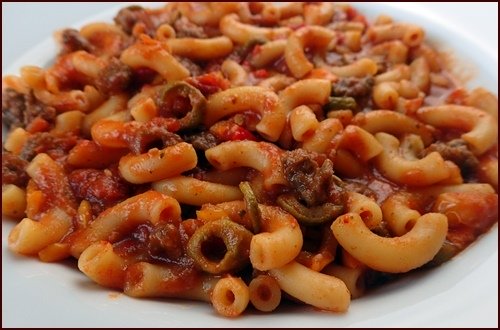

Share this page with friends on social media.
Free E-book & Newsletter
Free with Trail Bytes subscription.
Dehydrating Food from A–Z

